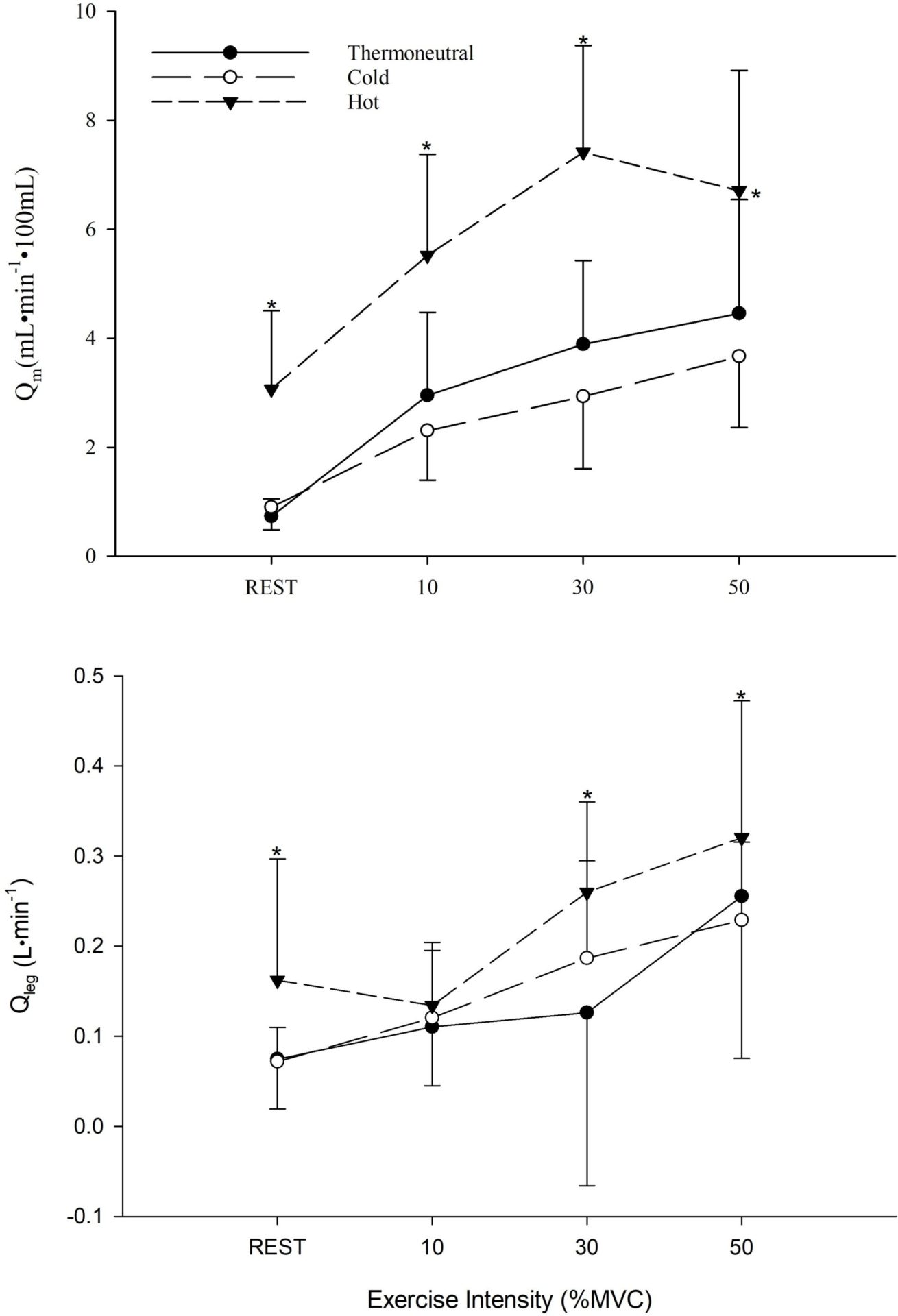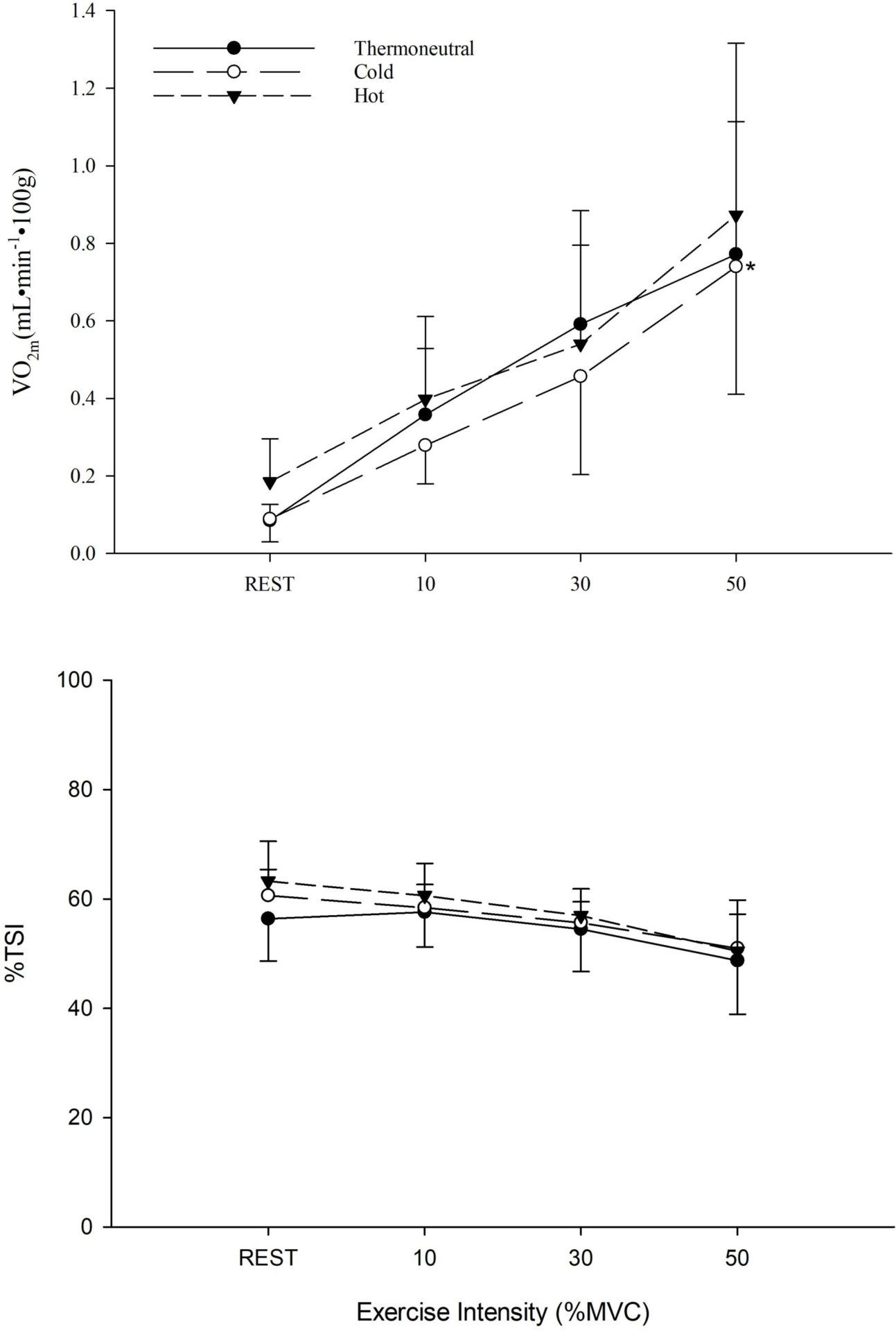Thermal changes in muscle tissue are known to influence its perfusive and diffusive O2 capacity (Hom et al, 2004; Yanagisawa et al, 2007; Wakabayashi et al, 2017). Nonetheless, whether a shift in oxygen transport and extraction in skeletal muscle during exercise modulates oxidative pathways, and is reflected in oxygen consumption (VO2m) and tissue oxygenation (%TSI), is unclear. The purpose of this study was to assess the effects of skeletal muscle cooling and heating on femoral artery blood flow (Qleg), muscle blood flow (Qm), VO2m, and %TSI during single-leg exercises. Eleven healthy males (23 ± 3.1 yrs, 77.6 ± 8.65 kg, 176.2 ± 6.99 cm) participated in a total of nine three-minute single-leg extension bouts on an isokinetic dynamometer set at 60°●sec-1. They each exercised at 10, 30, and 50% of their maximal voluntary contraction (MVC) under the following three thermal conditions: thermoneutral (TN: no change in muscle temperature (Tm)), cold (CO: -3°C in Tm), and hot (HT: +3°C in Tm). Tm was measured using an intramuscular flexible probe. Near-infrared spectroscopy was used to assess %TSI, as well as changes in Qm and VO2m through venous and arterial occlusion techniques. Qleg was assessed via Doppler ultrasound. Two-way RM ANOVA was used to assess differences in muscle oxidative and hemodynamic responses. Statistical significance was set at p<0.05. Results are reported as mean ± standard error. Qleg was greater in HT vs. TN and CO at rest only (p>0.05). Qleg was further influenced by exercise intensity (p<0.05) as rest was lower compared to 30%, and 50% MVC (0.103 ± 0.021 vs. 0.191 ± 0.024, and 0.268 ± 0.042 L●min-1; p<0.05). At rest Qm and VO2m were influenced by exercise intensity (p<0.001) and thermal conditions (p<0.05). Qm was higher in HT vs. TN, and CO (5.680 ± 0.488 vs. 3.008 ± 0.35, and 2.453 ± 0.241 mL●min-1●100mL; p<0.001). Qm increased with exercise intensity but no differences were observed between 30% and 50% (4.747 ± 0.406 vs. 4.946 ± 0.473 mL●min-1●100mL; p>0.05). VO2m was lower in CO vs. TN, and HT (0.391 ± 0.050 vs. 0.451 ± 0.056, and 4.99 ± 0.066 mL●min-1●100g; p<0.05). VO2m steadily increased with exercise intensity and was different between all intensities (p<0.05). %TSI was significantly lower at 50% MVC vs. rest, 10%MVC, and 30%MVC (50.068 ± 2.461 vs. 60.104 ± 1.751, 58.893 ± 1.441, and 55.715 ± 1.405 %; p<0.05). These results indicate that localized thigh cooling and heating modulate the well established link between Qleg and Qm at rest and during single-leg exercise. Despite clear influences of cooling and heating on perfusive and diffusive O2 capacity via changes in Qm and VO2m, tissue oxygenation was not significantly affected, suggesting intrinsic factors involved in maintaining tissue oxygenation under homeostatic challenges.
Physiology 2019 (Aberdeen, UK) (2019) Proc Physiol Soc 43, PC120
Poster Communications: The influence of temperature on localized muscle oxygen uptake, oxygenation, and blood flow during exercise
A. McCue1, J. Peltonen3, N. Beckett-Brown1, O. Seresse1, D. Marsh2, D. MacLean2, D. Gagnon1
1. Human Kinetics, Laurentian University, Sudbury, Ontario, Canada. 2. Northern Ontario School of Medicine, Sudbury, Ontario, Canada. 3. Foundation of Sports and Exercise Medicine, University of Helsinki, Helsinki, United Kingdom.
View other abstracts by:
Where applicable, experiments conform with Society ethical requirements.


